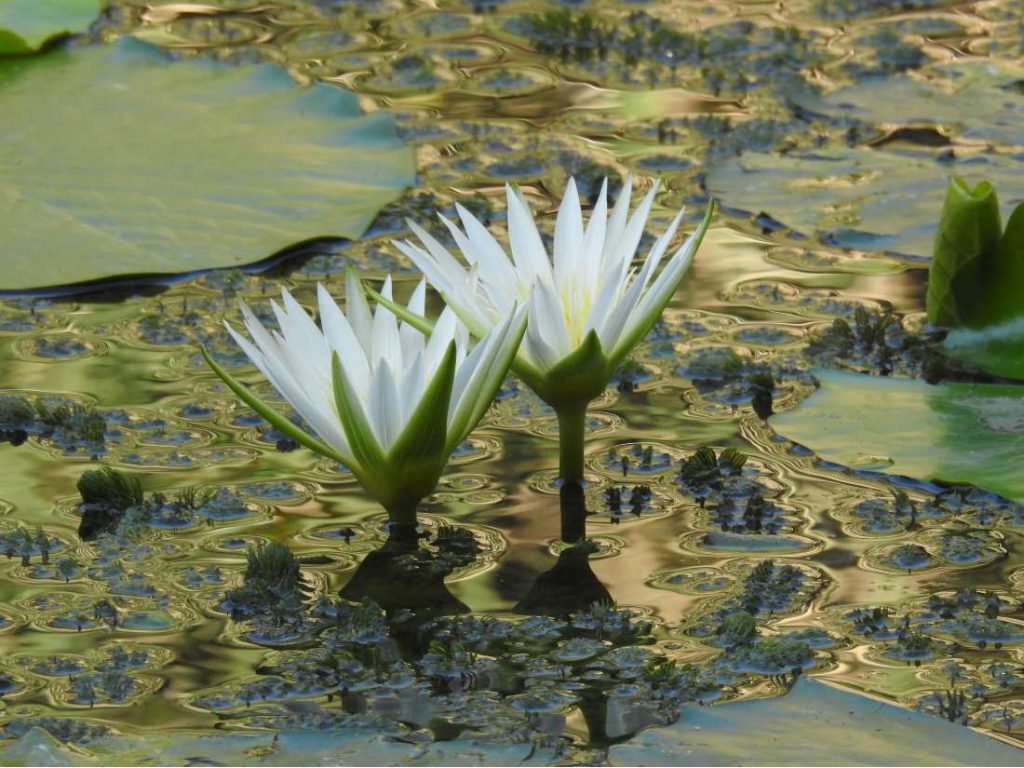Vegetation
Up to about forty five years ago, clean water flowed in the Yarkon, suitable for fishing, swimming and recreation.
In it were many diverse submerged, floating and protruding aquatic plants. Between the 1950’s and 1980’s species unique to the Yarkon’s wet habitats disappeared, following the accelerated development of the river’s surroundings and drainage basin, and after the Yarkon Sources were streamed to the Negev from 1955 onwards, great changes began in the river’s natural ecosystems.

Blue nymph – a plant typical of moist habitats that is in the process of returning to the river.
About 24 years ago, mapping work of the submerged, floating and protruding aquatic vegetation was carried out along the eastern section of the Yarkon, from the Rosh HaAyin springs to about 500 meters west of the Yarkon junction with Nahal Shilo it was found that certain species disappear completely, including common water crowfoot, Yarkon Reed, lakeshore bulrush, common duckweed, different pondweed, giant horsetail and more. The distribution of other species, which previously extended over long parts of the Yarkon, has been reduced to only its eastern sections.
The Yarkon River Authority has been leading the plan to rehabilitate the Yarkon along with many other organizations: the Nature and Parks Authority, the Botanical Gardens, the Institute for Nature Conservation Research at Tel Aviv University, the Society for the Protection of Nature and others. The rehabilitation plan included a remapping of the parts of the river that were mapped in the early 20th century, in order to try and track the changes that occured in the Yarkon’s vegetation in recent years.
It turns out that extreme changes occured in the composition of the species growing in the body of water. Of seven species of plants that once grew in the eastern part- blue waterlily, shore rush (Scirpus), ludwigia stolonifera, holly-leaved naiad, paper reed, london pondweed and yellow water lily- only the last two species remained. The population of the Yarkon reed, which was first collected from the banks of the Yarkon, has become extinct and can now be found along with other original populations from the Yarkon in the “Shelter Garden” in the Tel Aviv University Botanical Gardens.
As part of the plan for rehabilitating the Yarkon, periodically original plant populations cultivated in
“shelter gardens” are returned to their original habitat. In the eastern part of the Yarkon blue water lily, paper reed, scirpus and holly leaved naiad were replanted, and the River Authority monitors the rehabilitation of these habitats year round.
Vegetation unique to the Yarkon River in the process of being returned to the river and its surroundings:
- Blue water lily (Nymphaea nauchali)- The blue water lily is a perennial water plant with a thick root which grows in sweet water. The plant has round, heart shaped leaves around 10-30 cm in size which float on the water. The flowers are a bluish-white hue, their diameter is 10-12 cm, held up by a long stem of various lengths according to the depth of the water. It blooms from March to September, growing in Israel in springs and pools. When the lily was on the verge of final extinction from the Yarkon, Prof. Moshe Agami transferred a number of its articles to the Abu Kabir Botanical Garden where it thrived. In the early 2000’s a number of its articles were transferred back to the Yarkon to several physically differing areas. In a number of these points the lily survived but no longer than two years, in one point it thrives to this day in the Tilapia Pool. Today a project is taking place in order to transfer it to the northern Nufarim Pool.
The plant’s level of vulnerability: extreme danger of extinction.
- Simplestem bur reed (Sparganium erectum)- A protruding perennial water plant with a cane root (similar to reeds). The plant is tall, reaching a height of 50-100 cm. Its leaves are strap-like and protrude above the water. It is used as a habitat and nesting area for waterfowl, which feed off of its fruits. It grows on the banks of pools, rivers and channels of steady, clear water. A water plant which usually populates clear and abundantly flowing bodies of water. A number of articles have survived in the Yarkon, these articles have been protected to prevent physical harm and their environment was improved to the optimal state for this species. In addition, a number of articles were taken for breeding and creating a shelter garden for this species in the Tilapia Pool at the Yarkon Sources National Park. After it bases itself in the shelter garden, the River Authority will transfer the plants to the River’s surroundings as part of the riverbank rehabilitation carried out by the River Authority.
Vulnerability level of the plant: vulnerable.
- The Yarkon reed (Cyperus corymbosus)- A perennial reed with protruding stems, towering to a height of 100-180 cm. This plant grows in a wide based cluster (this is an expanded cane root) of 10-20 unbroken, leafless canes. The cane is round at its base and triangular at its top part. Its Hebrew name is a bit misleading; although it was first found in the Yarkon, it has since become extinct there, and today its main spread in Israel is in the Hula Valley. In Israel its typical habitats are on the beds of rivers and streams coming from springs. In 2018 a shelter garden for the Yarkon reed was founded by the Tilapia Pool at the Yarkon Sources National Park. The returning of the reed is part of every riverbank rehabilitation project conducted by the River Authority. The first location the reed was returned to is the fish ladder at Ten Mills, where it is developing nicely.
Vulnerability level of the plant: Severe danger of extinction.
The Yarkon River Authority
Adress: Kiryat Atidim Building B7, 3rd floor
Mailing address: P.O. 58292
Phone: 03-5460233
Email: [email protected]